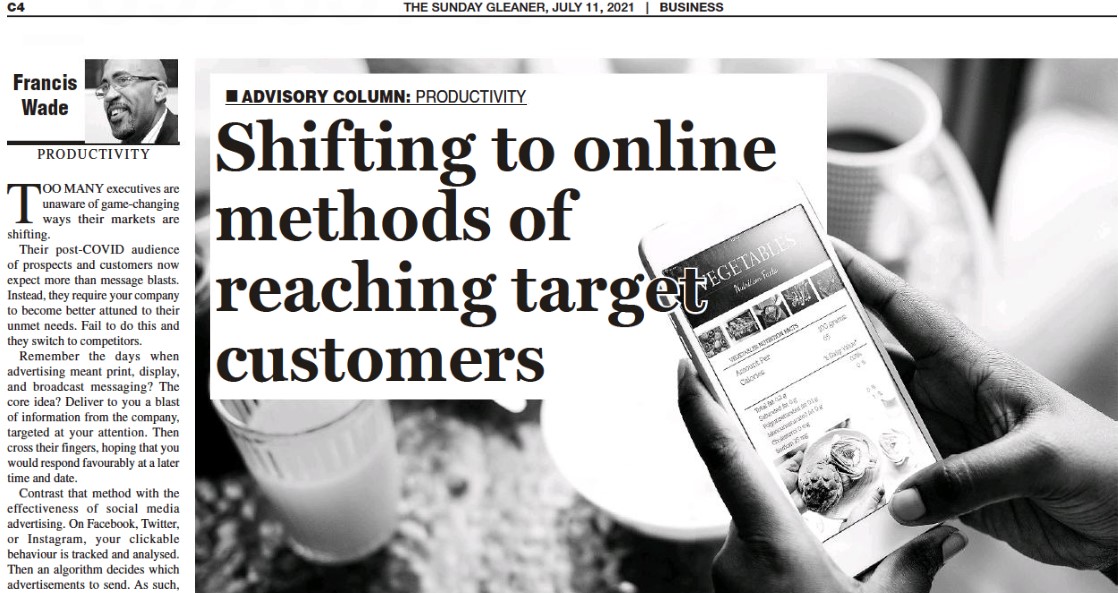Too many executives are unaware of game-changing ways their markets are shifting. Their post-COVID audience of prospects and customers now expects more than message blasts. Instead, they require your company to become better attuned to their unmet needs. Fail to do this and they switch to competitors.
Remember the days when advertising meant print, display, and broadcast messaging? The core idea? Deliver to you a blast of information from the company, targeted at your attention. Then, cross their fingers, hoping that you would respond favorably at a later time and date.
Contrast that method with the effectiveness of social media advertising. On Facebook, Twitter or Instagram, your clickable behaviour is tracked and analyzed. Then, an algorithm decides which advertisements to send. As such, you receive a highly customized and targeted set of messages.
If you are a typical executive, you may be dimly aware of the difference between old and online methods. An interesting factoid.
However, you should pay closer attention.
The companies who are using online messaging are “learning” more about their customer’s unmet needs than you can imagine. They’re analyzing the details to draw powerful conclusions.
It’s an improvement over the prior state of affairs, captured by John Wanamaker’s joke: “Half the money I spend on advertising is wasted; the trouble is I don’t know which half!”
With today’s technology, one can actually tell. How should your business use this capability?
- Track changing customer behaviour
If your company isn’t doing business online yet, you may explain that your customers are not to be found there in large numbers.
But that’s not a valid reason: you can use online interactions to learn about your customer’s behaviors, even if their numbers are small.
For example, your firm can test a hundred marketing messages to see which ones bring people into your funnel. Then, in your next step, apply different followups to determine how they react.
Consider it to be a cheap way to do critical research.
This level of detailed information puts your ads on broadcast media to shame in terms of its feedback value. Better yet, you should be able to learn where behavior changes lead to long-term habits that didn’t exist before.
This kind of precision is taken for granted by online advertisers, but few traditional marketing executives understand its power firsthand. The learning curve is too steep. As such, COVID has catalyzed changes they can’t track.
Consequently, many companies are being left in the dark by competitors who are gaining deep intelligence. Your best customers may be at risk.
- Conduct experiments on fresh innovations
A side-effect of this new capability is that your organization can shorten the time it takes to confirm an original product or service. This solves an age-old problem: how can you determine which offerings to bring to market?
In the online era, you actually don’t even need to sell anything to find out. Simply create advertisements for a new imaginary offering and see how an audience responds.
It’s a form of advanced market research that works far better than asking people whether they like something or not.
Imagine, you can bring prospects all the way to the point where they enter credit card numbers, revealing their intent to pay. In this approach, you are following their actual behavior, not their surveyed opinions.
Plus, you should gather groups of likely customers in a single place and partner with them to build the first version of your introductory offering.
As your fans, they give you valuable feedback that helps you craft the new product or service for the larger mainstream market.
These experiments deliver you invaluable data quickly, giving you a powerful advantage. The cost? Minimal.
- Anticipate Unmet Needs
Finally, you can even track the precursor to prospect’s new behaviours – unmet needs. By definition, these make up a moving target. Why? As customers absorb your prior innovations, they outgrow your existing solutions. Breakthrough technologies accelerate this process, leading them to start looking earlier than ever for replacements.
COVID has accelerated these changes, but many organizations will close down waiting for old behaviours to return. For most, the “new normal” is one they can’t anticipate: they just don’t have the information necessary.
Better, smarter companies will arrive at the same point in time with a bunch of data on their new customer’s needs. They’ll have innovations lined up which might be in demand by customers who know when they’ll be released.
Does your firm believe that after COVID finally departs it plans to launch a big, traditional advertising blast? If so, you could be making an egregious error.
Instead, take action now to develop the sophisticated information to build deep relationships that anticipate customer’s unmet needs.
Francis Wade is the author of Perfect Time-Based Productivity, a keynote speaker and a management consultant. To search prior columns on productivity, strategy, engagement and business processes, send email to columns@fwconsulting.com

